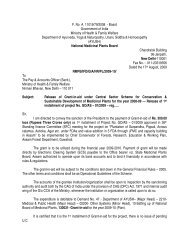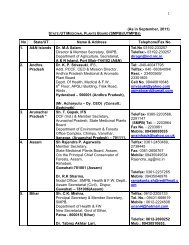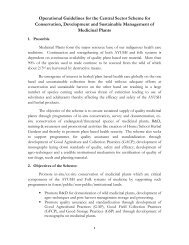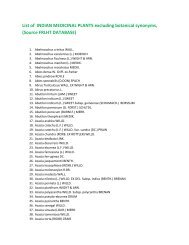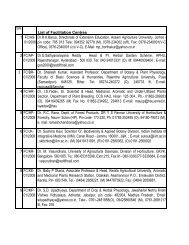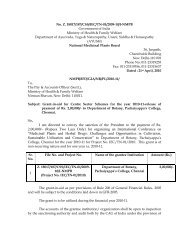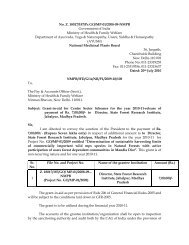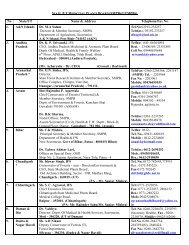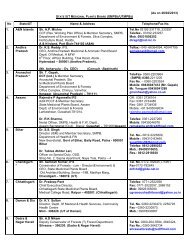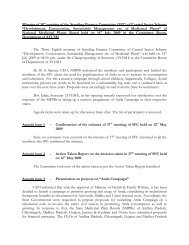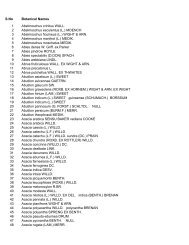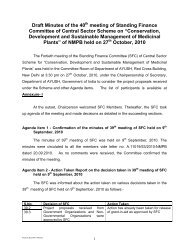METHODOLOGY FOR SETTING RESEARCH PRIORITIES ... - NMPB
METHODOLOGY FOR SETTING RESEARCH PRIORITIES ... - NMPB
METHODOLOGY FOR SETTING RESEARCH PRIORITIES ... - NMPB
You also want an ePaper? Increase the reach of your titles
YUMPU automatically turns print PDFs into web optimized ePapers that Google loves.
2. EXISTING SYSTEM <strong>FOR</strong> SUPPORTING <strong>RESEARCH</strong>After receiving a research proposal, the experts of <strong>NMPB</strong> examine it and mark it toreferee. The project is put up to Project Screening Committee (<strong>NMPB</strong>) with comments of thereferee. If the proposal is found promising the Project Investigator is called for makingpresentation before <strong>NMPB</strong>. The proposal is put up before Standing Finance Committee with thecomments of <strong>NMPB</strong>. F the project is recommended for support, the PI is called for presentationbefore SFC. If the SFC approves the project, then only the project is implemented with supportfrom the <strong>NMPB</strong>. The thrust area for research for 11 th Five Year Plan is as follows:• Collection, compilation and documentation (digitization) of published scientificinformation on various aspects of selected Indian Medicinal Plants and ASU productsand preparations of comprehensive monographs thereof and CTDs.• “Identification of substitutes / adulterants for traded medicinal plants for theirsubsequent inclusion in the Ayurvedic Pharmacopoeia of India”.• Finding substitutes for RET listed medicinal plants and finding use of sustainable plantparts like leaves, fruits etc in place of barks, roots, heart wood etc.• Research aimed at improving the technologies and lowering cost of production ofextracts, phytochemicals, natural colors, flavors etc. by using latest technologies.• Bio-Activity Guided Fractionation – for linking the phyto-constituents with the desiredbiological activities, with an aim to achieve standardization of herbal substances withbiologically active marker compounds.• Development of HPLC methods for known phyto-constituents (preferably the bioactives/ marker compounds) and validation of these methods as per international norms.• For medicinal plants in which commercially pursued phyto-constituents are known,study of seasonal variations, study of phyto-chemical variations within availablegenotypes, chemotypes, ecotypes etc., development of post harvest treatments, searchfor elite quality germplasm and development of quality planting material for mass scalepropagation.• Development of agro-economics (including agro-economics) for Indian medicinal plantswith an aim to work out the “fair price” to growers.• Development of effective and safe methods to reduce mibrobial load of crude herbalraw material.22
3. NEED <strong>FOR</strong> <strong>METHODOLOGY</strong> <strong>FOR</strong> <strong>SETTING</strong> <strong>RESEARCH</strong><strong>PRIORITIES</strong>Usually a researcher proposes a project on the basis of review of literature,intellectual curiosity, continuation of past work and his perception of reality. Further, quiteoften he indulges in making tall and exaggerated claim about potential impact of theproject. Probably following the policy of live and let live, most of the time the peer groupapproves the project without subjecting it to a critical appraisal. The research results,emanating from such projects are not adopted by research users and they seldomblossom into viable technology. At the same time the researcher does not duly addressmany problems, being faced by research users. The realistic appraisal of researchscenario clearly establishes mismatch between the user’s problems and research agendaof the researcher. There is tendency to jump straight on projects without going in detailsof its realistic contribution. Though research project and its implementation shall consumeresources, its contribution towards the solution to the medicinal plants problems is themore important aspect to be considered for the identification and prioritization of projects.It has been observed that when individuals are asked to identify research needs, they arelikely to respond with traditional, technical topics dealing with genetics, medicinal plantsmanagement, utilization etc. It is more meaningful way to identify research projects byidentifying role of research in addressing important and/or emerging medicinal plantsissues/problems.Setting medicinal plants research priorities may stand for selecting a balancedresearch portfolio with respect to needs of states, region and country. Further, given theimportant role India has been playing in medicinal plants at international level andpotentiality of the country in the sector, international perspective needs to be addressed inthe research agenda. There is also need to take into account mandate, structure,capability and strategic advantage of an organisation while setting its research priorities.Besides, research quality is improved with promotion of innovations in research andpassion for excellence among researchers. Therefore, the methodology for settingresearch priority for <strong>NMPB</strong> must attempt to achieve optimisation among complex anddiverse research needs and utilization of resources; objectives, structure and strategicadvantage of the institutions and potentiality and preferences of researchers with creating23
esources. An attempt has been made to achieve consonance through the methodology byassessing research needs from research users and providing research priorities in problem andthematic perspectives to researchers to identify and formulate research projects. The other twofactors were addressed through criteria of prioritisation and mechanism of Research AdvisoryGroup and Research Policy Committee.(v) Research Coordination- Given the nature of diverse medicinal plants conditions and largenumber of research and user organisations in India, coordination has to be key component ofresearch prioritisation. Further, the coordination to be taken in broader perspective. An attempthas been made to address the issue through establishing research coordination committee inState Medicinal plants Department, <strong>NMPB</strong> Institution, Research Advisory Group and ResearchPolicy Committee. Further, participation of researchers and research managers in the stateworkshop and research user and research manager in the institute workshop and all groups ofstakeholders in national workshop give boost to research coordination.(vi) Promotion of Passion for Excellence and Innovation – The passion for excellence andinnovation is required for the growth of individual scientists, organisation and good quality ofresearch. The environment in the organisation plays critical role in promoting the passion. In themethodology all researchers have been treated equally for formulation and implementation of theproject. Prioritisation in transparent manner with PSC mechanism is likely to encouPSCecompetition, which in turn will promote passion for excellence and innovation.5. <strong>METHODOLOGY</strong> <strong>FOR</strong> <strong>SETTING</strong> <strong>RESEARCH</strong> <strong>PRIORITIES</strong> <strong>FOR</strong><strong>NMPB</strong> FIRST PHASEThe methodology ensures three levels of prioritisation viz. prioritisation of researchproblems as perceived by research users, prioritisation of research themes and prioritisation ofresearch projects, with equitable participation of all groups of stakeholders. It recognisesinterlinkages among research problems, themes and projects in logical framework andprioritises them in sequential and integrated manner. Increase in production could be oneresearch problem area for the user point of view. For increasing the production, we may haveto follow the research theme of (development of agro-techniques, development of GoodAgricultural Practices for the species, optimal processing system for the species). Thus themethodology follows a natural direction from broad grassroots issues (practical problem) to less26
oad issues of research themes in scientific manner and then to specific research projects.The processes, stages and mechanisms of the methodology have been discussed in details insucceeding sub-chapters. The methodology uses set of ten criteria to be finalized on the basisof Questionnaire – I (Annexure – 1) for prioritization of projects.5.1 Prioritization of ProblemsResearch problems from the field bring in practical utility and meaningfulnessof the research. This will keep researcher on toe and motivate them as their work isgoing to be utilized and critically reviewed. The problems, for which solution exists,are to be handed over to extension division to provide extension service. Questionnaire-II(Annexure – 2) is to be used to get ten research problems from each respondent to decide finallythe most important research problems for each state. Questionnaire-1 is open ended asrespondents may select all ten problems from the suggestive list or may add problems from theirside. The suggestive list of the problems gives almost exhaustive list of the major problems of thecontemporary medicinal plants in India and corresponding major offshoots to identify specificproblems and approach to be given priorities to manage the problems. The Questionnaire is filledin the first day of workshop and on the next day the result of the problem is put up for discussionand respondents are given the opportunity to change their selected problems and correspondingscore if they like to do so as required in modified Delphi Technique. For the problems associatedwith the species, respondents are also requested to indicate three species along with assigningscore out of 10 to each species.5.2 Prioritization of ThemesThe methodology provides a comprehensive list of research themes in Questionnaire – III(Annexure – 3). The prioritization of the theme is carried out with equal weight to each group ofresearch user, researcher and research manager. Thus individual research manager gets veryhigh importance, followed by researcher and then research user in the context of prioritization ofthemes as the number of research managers is less than researchers who are less in numberthan users. This system has been incorporated in the methodology in due appreciation ofexpertise of research manager and researcher in prioritizing research themes, which have beenidentified on the basis of scientific analysis of the medicinal plants problems and possible scientificthemes to address these problems and required medicinal plants themes for the development ofmedicinal plants sector in India. Further, the list of themes are open-ended with due recognition27
of dynamic nature of the research. The themes are to be prioritised with all India perspectives asrespondents are asked to keep national scenario in mind while scoring against the themes. Therespondents give also opinion about inclusion of the themes in short term, middle term and longterm priorities on the basis of urgency of addressing the themes. At times it may be difficult for anindividual to comment on such a large number of themes. Therefore, the Questionnaire givesthe option to the respondents not to fill up for the themes for which they may not like to commentor they may be ignorant about their importance. Thus, Questionnaire-II provides system forprioritizing research themes according to their importance. For calculation for the inclusion of thework in short term, medium term and long term plans, the score 3, 2, 1 are assigned for shortterm, middle term and long term in due appreciation of relative importance for starting theresearch work immediately, the work may wait for 2-3 years and to be taken up after five yearsrespectively. Average PSCs score (for the inclusion in different plans) less than 1.5, between 1.5and 2.49 and equal to or more than 2.5 stand for theme to be included in long term, medium termand short term plan respectively.5. 3 Prioritization of ProjectsThe methodology also incorporates objective method for prioritization of research projectsto be formulated by researcher. The method is based on calculation of index score by multiplyingaverage PSCe score with respect to a particular criterion and corresponding weight of the criterionand summing up them for the selected set of criteria. All projects have to be prepared on a formatdiscussed in details in subsequent section. These projects are to be prioritized by the members ofResearch Advisory Group (PSC) at institute level and Research Policy Committee (RPC) atnational level.The methodology provides for the prioritization of projects on the basis of set of tencriteria. Questionnaire-I has been designed for selection of criteria and assigningcorresponding weights. It identifies criteria and assigns weight for project prioritization. TheQuestionnaire gives a list of suggestive criteria, but the respondent is free to add further criteria.In due appreciation of the importance in Indian medicinal plants context, compatibility with themethodology and institutional set up, four criteria viz users needs, importance of researchthemes, scientific advancement and scientific leadership to <strong>NMPB</strong>, have been made essentialcriteria. The respondents shall select other six criteria for prioritizing projects. However, theyshall give weights to all ten criteria. The first two criteria viz users needs and importance ofresearch themes have to be kept in the set of criteria for prioritization of research projects tohave correspondence in prioritization of research projects with that in problem and thematic28
perspectives. Analysis of data of Questionnaire-III (Annexure 3) shall provide set of ten criteriaalong with corresponding weight. Ten most favored criteria inclusive of four essential criteriaare to be selected and their weights for each criteria are calculated by taking weighted average(equal weight to research user, researcher and research manager) of the weights given from 0-10 by respondents. For convenience these weights are scaled in such a manner that sum ofweights for ten criteria becomes hundred as shown in Table 6.4. The rationale behindconversion to the scaled weight is to increase the visibility of the weight and shift to the mean ofthe index score of projects in an institute to 500. This may be used for the calculation ofnormalized/ rationalized index score.Table 1 : Calculation of Scaled Weight for Selected CriteriaS.No.CriteriaAvePSCe weight (fromQuestionnaire III)ScaledWeight1 User's needs ( state research problem) 5.34 112 Scientific advancement 6.31 133 Scientific leadership to India 5.82 124 Importance of research themes4.37 9(priority of research area)5 Economic benefit (increase in productivity) 7.28 156 Improvement of environment quality 4.86 107 Chances of developing a patent 4.85 108 Poverty alleviation (creation of employment3.88 8opportunity)9 Historical trend (institute or researcher's expertise) 3.40 710 Consumption of Resources (high consumption low2.42 5score )Total 48.53 100Source: Prasad, 1997Note- Above table has been given as an example. Actual set of criteria used for prioritisation inthe methodology were calculated on the basis of processing the Questionnaire-III.The prioritised list of research themes and research problems are used for prioritisingresearch projects, as they constitute two essential criteria for prioritisation of research projects.Besides, they may provide direction to the project formulation. Further, there is strongrequirement that projects, addressing important problems and themes should get higher positionin the prioritised list of the projects. While identifying a research project, a researcher knows thathis project is going to be accepted or rejected on the basis of index score to be calculated onthe basis of ten criteria and corresponding weights and score given by PSC members. He has29
the opportunity to specify problems and themes (along with their scores, indicating theirimportance), being addressed by his project in the item no.105 and 106 of the Project Format-I(Annexure 6). Further, he is expected to justify how the project is meeting the requirement ofproblems and themes in item no. 2301 and 2304 respectively in the same format. It is expectedthat he discusses these issues in his presentation before PSC members. After going throughthe project proposal and listening to the presentation, PSC members give score against eachcriterion with reference to the project. AvePSCe score of PSC is calculated by simpleavePSCing and thus all PSC members are treated equally. Summing the multiplication ofweight of the criteria to corresponding score (given by a PSC member), an index score for theproject allotted by one member of PSC may be calculated. The index score for project iscalculated on the basis of Weighted Criteria Method as shown below by an example:Table 2: Example of Calculation of Index Score of A Project on Development ofSeedling Seed Orchard & Clonal Seed Orchard of TeakSl.N.CriteriaScaledWeightAvePSCeScore of PSC1 User's needs ( state research problem) 11 102 Scientific advancement 13 63 Scientific leadership to <strong>NMPB</strong> 12 74 Importance of research themes9 9( priority of research area )5 Economic benefit (increase in productivity) 15 86 Improvement of environment quality 10 47 Chances of developing a patent 10 68 Poverty alleviation (creation of employment opportunity ) 8 59 Historical trend (institute or researcher's expertise) 7 610 Consumption of Resources ( high consumption low score ) 5 6Total 100Index score of the Project = 11x10+13x6+12x7+9x9+15x8+10x4 +10x6+8x5+7x6+5x6= 110+78+84+81+120+40+60+40+42+30= 685Thus, every project shall get an index score. This index score is used for prioritising theresearch projects. An example of prioritising research projects may be seen in Table 6.530
Table 3 : Prioritisation of Research ProjectSNProject AvePSCe Score Against Criteria Ave1. Screening ofrecalcitrant andintermediatemedicinal plantstree seeds2. Geneticimprovement ofEucalyptusthroughhybridization3. Efficiency oforganic vis-à-vischemical fertilizerin improving theproductivity ofsodic soils.4. Socio-economicimpact of JointMedicinal plantsManagement5. Development ofdegrade freesawing andseasoningtechnique for lowgirth EucalyptuslogsSource: Prasad, 19971(11)2(13)3(12)4(9)5(15)6(10)7(10)8(8)9(7)10(5)PSC’sIndexScore6 10 10 7 5 7 9 2 9 5 71810 6 7 9 8 6 6 5 7 6 7127 8 8 5 6 8 3 8 7 8 6758 5 7 8 7 7 2 9 5 6 6419 6 6 6 7 4 4 6 8 4 612Note – The figure in parentheses indicates scaled weight of corresponding criteria. These are justfor example. Actual criteria and weights is decided only after collection and processing of data inQuestionnaire-III (Annexure III) as given in the chapter 7.5.4 Normalization of Average Index Score and Prioritisation of All ProjectsAs discussed in Sub-chapter 5.3, projects would be proioritised on the basis of averageindex score, calculated from the scoring of RAG members. But the average index score ofprojects of one institute may vary from projects of the other institute. To bring in objectivity,31
compatibility and comparability, these is need to normalise there scores of projects. Thenormalised score of each project may be calculated by using following formula:Normalised Score= 500+Zx250and Z = (x-µ)/σWhere Z=Z value of the normal distribution.x=Average under scoreµ=Mean of average index score of projects in the PSCσ=Standard deviation of the average index score of theprojects in the institute in one RAG meeting6. <strong>METHODOLOGY</strong> <strong>FOR</strong> <strong>SETTING</strong> <strong>RESEARCH</strong> <strong>PRIORITIES</strong> <strong>FOR</strong><strong>NMPB</strong> SECOND PHASEA comprehensive methodology detailed on section 5 would be implemented for settingmedicinal plants research priorities for India. The methodology has been shown schematicallyin the Diagram 6.1. As shown in the diagram the methodology is expected to provide researchprioritisation with due consideration to emerging medicinal plants scenario in India, changingglobal medicinal plants scenario, contemporary development in science and technology andsocial economic conditions and national policies.As shown in Diagram 6.1, the methodology starts with a national workshop to deliberatecritically the draft methodology to achieve consensus on it. The selection of nodal officer /agency for carrying out preparatory works for organizing state workshop and formulation of draftstate medicinal plants research plan as envisaged in the methodology follows the instituteworkshop. State workshops one each in a state are organised to deliberate draft state medicinalplants research plan and decide medicinal plants research priorities. On the basis of inputsfrom prioritisation of problems and themes from the methodology and state medicinal plantsresearch plan of the states, mandate of the institute and capability of the scientists, the draftresearch plan of ICFRE institute is formulated. The draft plan of ICFRE institutes is deliberatedand discipline wise projects are identified in workshop organized one each in the eight ICFREinstitutes. The identified research projects are formulated and presented before PSC for32
prioritisation at institute level. Finally National Medicinal plants Research Plan is formulatedand adopted in Medicinal plants Conference.Diagram 6.1 Methodology for Setting Medicinal Plants Research Priorities for IndiaChanging Global Medicinal plants ScenarioEmerging Medicinal plants Scenario in India (includingdemand and supply of forest products)ResearchProjects(SpecificIssues)ResearchThemes(Scientificissues)Medicinalplants Problem(Broad Issues)MedicinalplantsConferenceInstituteWorkshopStateWorkshopNationalWorkshopNationalMedicinalplants ResearchplanResearchplan ofRegionStateMedicinalplantsResearch PlanContemporary Development in Science and TechnologySocio-economic Condition and National PoliciesSource: Prasad and Negi, 1999Further, as shown in the diagram the methodology ensures three levels of prioritisation viz.prioritisation of research problems as perceived by research users, prioritisation of researchthemes and prioritisation of research projects, with equitable participation of all groups ofstakeholders. It recognises interlinkages among research problems, themes and projects inlogical framework and prioritises them in sequential and integrated manner.33
The score of the prioritised problems in the states may be used to prioritise researchproblems in a region or in country with the help of the weights assigned to each state inaccordance to objective criteria. In view of the present medicinal plants scenario in India, issuesto be addressed and availability of data, population and forest area are two most important criteriafor assigning the weights to the states as population has direct correlation with demand onforests, need for agro-medicinal plants etc, where as forest area has relationship with thebiodiversity conservation, soil conservation etc. Further, the weights may be rationalised. Thismay be carried out assigning a fixed weight (say 100) to a state scoring maximum against thecriterion and calculating weight of other states with reference to the state, scoring maximum withrespect to the criteria. A minimum weight for smaller states (say 10) may also be fixed. withrespect to each criterion so that political and geographical identity of a state is duly recognised.Using the aforesaid method Scaled Weight of each state has been calculated in Table 6.2 onthe basis of population and forest cover of the state. The data on population and forest cover ofstates were taken from 1991 census (GOI, 1991) and State of Forest Report, 1997 (GOI, 1998)for calculation of Weight of State. As population was maximum in Uttar Pradesh, (U.P.), theweight of 100 was assigned to the state with respect to the population criterion. The weight ofother states with respect to criterion was calculated in proportion to their population ascompared to that of U.P. and a minimum of 10 weight was assigned to these weights. Similarly,as forest cover was maximum for Madhya Pradesh (M.P.), 100 was assigned to the state on thisaccount. The weights of other state on this account was calculated in proportion to their forestcover with respect to that in M.P. with minimum 10 for each state. The weight (geometricmean) of the state was calculated by taking square root of the product of the two weights(population and forest cover) of state. Taking squared root of product was found morerepresentative than taking average (arithmetic mean). Finally scaled weight was calculated bydistributing a total of 1000 among states in proportion of their weight as shown in Table 6.2using the above method. For calculation of regional and national research priorities in problemperspective, following formula is used :Where,Sn∑ wD i ×iWeighted score of problem n = iw× 100∑i34
Sn i = total score n th of problem, in the i th stateD i = number of respondents in the i th stateW i = weight of the i th state as given in Table 6.2Problems coming up to 80% of accumulative score are to be included in the list ofpriorities. The problems coming below 80% of accumulative score are treated as unimportantbecause area, under lower tail from point of inversion in normal distribution curve may beignored for prioritisation. Though point of inversion depends on the shape of the curve, 20%was taken as cut off for maintaining uniformity in rejecting the unimportant problems. ForProblems coming at higher places in the prioritised list of the problems of given region and SFDis not in position to address them, regional institutes is expected to prepare research projects onthem. Regional priorities in problem perspectives provide one of the most important basis forformulation of research plan of region. At each region level an institute of ICAR / CSIR/ DST/DBT shall be selected. A concept of CTA chief technical adviser for important species or issuesof medicinal plants would be selected and support system developed.6.1 First National WorkshopEvery aspect of the methodology is discussed and finalised. The format of statemedicinal plants research plan, research plan for region, research projects, may also bediscussed and finalised. Specific case studies on these issues are discussed in the workshop formore clarity in understanding. The workshop provides platform for consultation and mechanismfor training of the nodal officer for preparing draft plans. The modalities of holding the stateworkshops may also be discussed and finalised. The workshop sets in the process ofimplementation of methodology by creating understanding about it as well as rejuvenatinglinkages among SMPB, State Mission, Facilitation centre and state forest departments. Thenational workshop sets in constitution of coordination committee, nomination of nodal officer anddeveloping consensus about formulation of draft state medicinal plants research plan.6.2 State WorkshopIn due appreciation of political identity of a state and administrative structure and systemin India, state has been selected as a basic unit in the methodology. State workshops, one in35
RegistrationInaugurationTechnical Session I -Programme Of First DayMethodology for Setting Research * & Filling up QuestionnaireITechnical Session II - Draft State Medicinal plants Research Plan **Technical Session III -Institute Presentation (objective, structure, achievement ¤t activities)***Programme of Second DayTechnical Session IV -Technical Session V -Technical Session VI -Vote of ThanksNational and Global Medicinal plants Scenario and EmergingStrategic Area of Medicinal plants Research*Result of Questionnaire I (Use of Delphi Technique)Filling up Questionnaire IIFilling up Questionnaire IIIDiscussion on medicinal plants research problems for thestate – identification of new projects and collaboration.Note - * Main theme paper in this session should be presented by representative ofICFRE** Main theme paper in this session should be presented by representative ofState Forest Department*** Main theme paper in this session should be presented by Director,identified institute of the regionThough the above format is suggestive and designed to achieve the objectives of theworkshop. Some adjustments may be made in the programme to meet specific local requirement.However, basic structure of the programme needs to be maintained for uniformity and systematicapproach in the implementation of the methodology.Thus as mentioned above all three questionnaires are to be filled in the workshops. Thestate level workshop provides the data for research problem in the state along with their score.Besides, data on research themes are collected in the workshop. Each important problem isdiscussed and possible research projects are identified in view of need of research to address theproblems. Proceeding of the workshop is an important input for formulation of the state medicinalplants research plan. In fact data generated and deliberations in the workshop make theformulation of state medicinal plants research plan realistic and provide substantial technicalinputs for the plan.37
6.3. State Medicinal plants Research PlanIt is expected that every state shall prepare state medicinal plants research plan (SFRP).The plan may follow the format given in Annexure 4. A sincere attempt is to be made to persuadeall state forest departments to write state medicinal plants research plan. In case few states donot come forward for formulating the plan some other agencies in the states may be requested todo so and data collected during the state workshop may be used for this purpose. As shownschematically in the diagram 6.1, SFRP is the first building block of the structural planningproposed in the methodology. In fact it adds broader perspective to the methodology in additionto make it more useful by connecting directly to the implementation at the field level in theintegrating manner. It is obvious that the format (Annexure 4) provides internal and externalconsistencies. It gives research carried out by the state in historical prospective and clearly statesthe research projects to be under taken by state. The plan must make sectoral review, analysepresent and future scenario, identify problems in forest management, prioritise research needs,assess the capability of state medicinal plants research agencies and decide need of nationalinstitutes to support state.6.4 Regional WorkshopA National Institute in a region would be identified as nodal institute for the region Theinstitutes are expected to fulfil medicinal plants research need of the region and undertake state ofart research to achieve national and global leadership in the disciplines assigned for centre ofadvanced studies. As shown in Diagram 6.1 institute workshops follow state workshops. Regionalworkshops one each the region to be organised by the core group for research coordination of theinstitute to achieve following objectives:• To review on going projects in view of research priorities of state, region & country• To discuss key inputs for formulation of research plan of the institutes• To discuss draft research plan of the region• To support and supplement process of participatory and transparent system ofmedicinal plants research planning in India• To identify research projects to be taken by the institutes• To identify collaborative organisations e.g. BSI, ZSI, WII, FSI etc. and individuals forcollaborative projects to avoid unnecessary duplication and achieve synergy inresearch effort• To try to identify division/discipline-wise goal, objective and strategy38
Regional workshop is to be organised for identifying discipline wise research priorities foreach ICFRE institute with due consideration to state level priorities and state medicinal plantsresearch plan and wider consultation with SMPB/ State Mission SFDs of the region and sisterscientific organisation. The necessity of basic, applied, adoptive research should be identified totackle user’s problem. The scientist of each discipline/division may try to identify goals, objectivesand strategy for each discipline. The discussion in the workshop must lead to identification ofprojects to be undertaken by each discipline. Further, it provides platform to identify collaborativeprojects. The delegates should be selected from SMPB / State Mission / Facilitation Centresin state forest departments; universities working in medicinal plants and allied sectors; selectedscientists of identified Institutes/Centres; representative of national research organisations e.g.BSI, ZSI, FSI, etc., representative of NGOs working in medicinal plants sector and forest basedindustries; eminent forest officers and scientists etc. Approximately 30-50 delegates should befrom outside of the institute. Particularly in the fields in which the institute is trying to get status ofCentre of Advance Studies, eminent researchers from other identified institutes and otherorganisations may be invited in the institute workshop. Institute plan must reflect institute prioritiesfor all disciplines. The proceeding of institute workshop is an important input for the research planof the institute. In view of progress already made in the implementation of the methodology asstate medicinal plants research plan will have been already prepared and research priorities atregional level in problem perspective and at national level in problem and thematic perspectivesare also available, the workshop is organised in the following format:Programme of First DayRegistrationInaugurationTechnical Session I - Research Priorities of State, Region and Country *Technical Session II -DepartmentsTechnical Session III -State Medicinal plants Research Plan of State ForestInstitute Presentation on Present & Proposed ResearchActivities of other Research Organisation in the Region.Programme of Second DayTechnical Session IV -Technical Session V -Technical Session VI -Valedictory SessionDraft Research Research Plan of the RegionDiscussion on goal, objectives, strategy and research projectsof division**Project formulation Process & Projects Formats*Recommendation & Vote of Thanks39
* Presentation by the representative of <strong>NMPB</strong>** Delegates may be divided into groups for in-depth discussion on proposed projectsand collaboration. Depending upon number of division/ discipline and nature ofwork, few of them may be clubbed while forming groups.Though the above format is suggestive in nature, its basic structure needs to be followedfor uniformity and achieving the objectives of the workshop. However modifications may be madein view of local requirements. Research priorities with particular reference to the need of regionshall be deliberated for two days in the workshop. As mentioned above, the inauguration of theworkshop shall be followed by presentation on the research priorities of states, region and countryby the representative of <strong>NMPB</strong>. Director of the institute shall present in details the draft researchplan for the institutes. The draft plan must be prepared in view of state level priorities and thestate medicinal plants research plan. The presentation of the Director should follow thepresentation of state forest departments and institutional presentation of other researchorganisations engaged in the medicinal plants research. After that, the delegates should bedivided into groups to discuss the priorities and projects for every division. The deliberation in theworkshop must lead to identification of research projects to be carried out by the identifiedinstitutes and collaborating organisations and individuals in case of collaborative projects.6.5 Research Plan of Identified InstitutesAll identified institutes need to prepare research plan of their institute. As shown in thediagram 6.1 preparation of research plan of institutes is the next step after formulation of statemedicinal plants research plan. Therefore, it has to deal with regional issues and share thenational requirements of the research projects. The plan must analyse medicinal plants scenarioin the region and identify research needs to be addressed by it as a result of analysis of data ofQuestionnaire-I of the region, SRP and institute level workshop. For uniformity, betterappreciation and analysis all institutes plans should have same format. After institute levelworkshop, discipline wise priorities are known to researchers. Accordingly they may prepareresearch projects and present them in front of RAG, which must prioritise these projects. Thusthe institute plan comes out with research projects along with its prioritisation. Besides, it givesshort term, middle term and long term research plan of each discipline. The plan must make arealistic view of capability, potentiality and preference of the researchers of the institute. Itshould also make an attempt to identify direction for developmental capability of the institute.Thus the institute plan is formulated for catering the research needs of the region and developing40
ANNEXURE ‐ 1QUESTIONNAIRE – INATIONAL MEDICINAL PLANTS BOARDPart - I : Information about respondent1. Name: ____________________________________________2. Organisation : ____________________________________________3. Profession : ____________________________________________4. State / A.N. ____________________________________________Part - II Criteria and Weight - The first four criteria are compulsory. Select additional sixcriteria from the list or write your own criteria, to make a set of 10 criteria. Kindly giveweight from 1 to 10 to the 10 selected criteria according to their importance. 10 is themaximum weight to be given to the most important criteria. You may give same weight totwo or more than two criteria, if you perceive that these criteria are equally important. Theselected ten criteria and corresponding weight will be used to prioritise research projects.Sl.No.List of criteria ( Criteria 1,2,3 and 4 arecompulsory. You may choose your ownsix criteria )1 User’s needs (state research problem)2 Scientific advancement3 Scientific leadership to India in field ofmedicinal plants4 Importance of research theme (priority ofresearch area)5 Revenue generation for self sustainability6 Economic benefit (increase in productivity)7 National demand and supply scenario ofthe product8 Sustainable harvesting & management offorest for medicinal plants9 Historical trend of research (expertise ininstitute/ scientist)10 Staff skill improvement11 Bio-diversity conservation12 Chances of getting a patent42Confirm yourselection ofcriteria [writeYes(1)/no(2)]Give weight to only10 selected criteria(1-10, 10 for mostimportant criteria)
QUESTIONNAIRE - IIANNEXURE ‐ 2NATIONAL MEDICINAL PLANTS BOARDQUESTIONNAIRE <strong>FOR</strong> PRIORITISING <strong>RESEARCH</strong> PROBLEM INSTATE <strong>FOR</strong> MEDICINAL PLANTSPart - I : Information about respondent1. Name : ________________________________________________2. Organisation : _______________________________________________3. Profession : ________________________________________________4. State / A.N. ________________________________________________Part - II List medicinal plants research problems in state and nature of collaborationWrite 10 important research problems along with name of three species, wherever applicableand score them from 1 to 10 according to their importance. 10 is the maximum score to be givenfor the most important problems. You may give same score to two or more than two problems, ifyou perceive that these problems are equally important. A suggestive list of problems has beengiven in the instructions for filling up this questionnaire. You may select problems from the listor write your own problems.SlNo.12345678910Research Problem ( Give the name of threespecies, wherever applicable)Give Score for problemsaccording to their importance(1-10, 10 for most importantproblems)44
Part - IISUGGESTIVE LIST OF <strong>RESEARCH</strong> PROBLEMS <strong>FOR</strong> QUESTIONNAIRE-II(BY <strong>NMPB</strong>)1 Survey and inventorisation and documentation of medicinal plant resources.2 Ecology and environment (Population studies of RET species of Medicinal Plants).3 Ethnobotany(Documentation of Traditional knowledge of Medicinal Plants).4 Reproductive Biology of Medicinal Plants5 Nursery Technology of Medicinal Plants6 Agronomy/ Agrotechniques of medicinal plants7 Intercroping of medicinal plants8 Soil Science related to medicinal plants9 Crop protection in medicinal plants10 Breeding and improvement of Medicinal Plants11 Cyto-Genetics of medicinal plants.12 Molecular Biology of Medicinal Plants13 Clonal Propagation of Medicinal Plnats14 Development of good harvesting/collection practices for medicinal plants.15 Resource Inventorization and Sustainable harvesting of medicinal plants.16 Post Harvest Management.(Drying garbling, Grading & Packing) of medicinal plants17 Primary Processing, Value addtion & Product formulation of medicinal plants.18 Pharmacology/pharmacodynamics of medicinal plants.19 Biological screening, isolation & characterization of active constituents in medicinal plants20 Bioactivity studies in medicinal plants.21 Phytochemistry of medicinal plants.22 Pharmaceutical ascpects of medicinal plants.23 Biochemical studies on medicinal plants.24 Morphology of medicinal plants used in AYUSH.25 Phrarmacognosy of medicinal plants used in AYUSH.26 Anatomy and Histrology of crude drugs of AYUSH.27 Seed morphology of medicinal plants.28 Seed technology.(seed standard & certification) for medicinal plants29 Seed Storage of medicinal plants.30 In-vitro propagation and conservation (tissue culture) of medicinal plants.31 Genetic improvement of medicinal plants.32 Genetic engineering in medicinal Plants.33 Conservation of medicinal plants34 In-situ Conservation of medicinal plants35 MPCA's, MPDA’s and refforestation efforts for medicinal plants.36 Natural regeneration of medicinal plants37 Ex-situ Conservation (Botanical Garden, Herbal Farm, Community Herbal Gardens, GeneBanks, Pollen Banks etc.).46
39 Demand and Supply status of medicinal plants both in term of internal consumption andforeign trade of medicinal plants.40 Trade routes, acts and laws relating to marketing of medicinal plants41 Taxonomy (Systemetics) of medicinal plants42 Human Resource Development skill development in medicinal plants43 Value addition and product formulation44 Extension System for medicinal plants47
ANNEXURE ‐ 3QUESTIONNAIRE ‐ IIINATIONAL MEDICINAL PLANTS BOARDQUESTIONNAIRE <strong>FOR</strong> PRIORITISING <strong>RESEARCH</strong> THEMESPart - I : Information about respondent1. Name : ________________________________________________2. Organisation : ________________________________________________3. Profession : ________________________________________________4. State / A.N. ________________________________________________INSTRUCTIONS <strong>FOR</strong> FILLING PART - I1. Write your name in Block Capital Letters.2. Write code, choose from the following : State Forest Department/SMPB/State Mission -1, Research Institutions - 2, NGO - 3, Medicinal Plants based industry - 4, MedicinalPlants cultivators / collectors - 5, Others -63. Write code, choose from the following : Scientists of ICAR, CSIR, ICFRE ResearchInstitutes/University - 1, Field officer in State Forest Department/SMPB/State Mission(resource manager) - 2, Research manager (officer or scientist in headquarters managingresearch) - 3, NGO -4, medicinal plants based industry-5 Medicinal Plants cultivators /collectors - 6, Others -74. Code of State and Andaman Nicobar IslandAndaman & Nicobar 1 Maharashtra 17Andhra Pradesh 2 Manipur 18Arunanchal Pradesh 3 Meghalaya 19Assam 4 Mizoram 20Bihar 5 Nagaland 21Chhattisgarh 6 Orissa 22Delhi 7 Punjab 23Goa 8 Rajasthan 24Gujarat 9 Sikkim 25Haryana 10 Tamilnadu 26Himachal Pradesh 11 Tripura 27Jammu & Kashmir 12 Uttarakhand 28Jharkhand 13 Uttar Pradesh 29Karnataka 14 West Bengal 30Kerala 15Madhya Pradesh 1648
Part -II Prioritising research themesKindly give score (0-10) to research themes according to their importance. 10 is the maximumscore to be given for the most important themes. 0 score means that you do not want that anyresearch should be carried out on the theme. Importance may be judged from the point of view ofuser’s needs, scientific advancement, scientific leadership of India. You may add more themes.Sl.No.Research Themes for prioritization for medicinal plants Score 0-10according toimportance1.0 Bio-diversity and Taxonomy of medicinal plants1.1 Distribution of medicinal plants in different climatic zone of India (atstate, Distt., Block & Panchayat level) using GIS tools.1.2 Systematic studies for documentation of medicinal plants.1.3 Population Status of Species of medicinal plants in natural habitat withrespect to their RET status.1.4 Biodiversity of medicinal plants, their distribution and utilization.1.5 Quantitative estimation of commercially exploited medicinal plantspecies for trade from natural habitats for reguleting are harvesting.1.6 Assessment of Rare, Endangered and threatened species.1.7 Prioritisation of RET species for conservation & cultivation using GISdatabases.1.8 Documentation of morphological diversity in medicinal plants.1.9 Inventorisation & Documentation of herbaceous species of Medicinalplants of different regions.1.10 Survey and Inventorisation of medicinal shrubs and clinber resources ofIndia.1.11 Inventorisation & Documentation of medicinal tree resources of India.1.12 Identification and enumeration of endemic species of medicinal plants.1.13 Status of medicinal plants diversity in different zones in India.1.14 Inventorisation & Documentation of herbaceous species of Medicinalplants of different regions.1.15 Survey and Inventorisation of medicinal shrubs and clinber resources ofIndia.1.16 Studies in ecological diversity of medicinal plants.1.17 Effect of associate species on growth, development and quality ofmedicinal plants.1.18 Study on change of micro & macroflora of medicinal plants undershifting cultivation.1.19 Characterisation of biodiversity and conservation of genetic resourcesof medicinal plants.1.20 Study on effect of climate change on growth & population of medicinalplants.1.21 Phyto-sociological studies of medicinal plants.49
1.22 Selection of sites for developing conservation areas for RET species ofmedicinal plant.1.23 Diversity, potential utilization and Bioprospection of Medicinal Plants ofIndia.1.24 Survey documentation of ethnomedicinal plants from various tribes inIndia.1.25 Documentation of medico-ethnobotanical knowledge prevailing amongrural and tribal proper in the country (Traditional Health Care).1.26 Documentation of Indian Phytotherapies for future validation.1.27 Documentation of \medicvinal Plants resources in of Sacred Groves inIndia.1.28 Biodiversity and traditional knowledge as a base for Drug discovery.1.29 Ethnomedicines of different tribals in India.1.30 Ethnomedicobotany of individual plants.1.31 Ethnomedicobotany of group of plants used for curing a particulardisease.1.32 Ethnomedicobotany documentation of germplasm of Medicinal valueand thin conservation Medicinal grasses.1.33 Documentation of Knowledge associated with medicinal plants of India.1.40 Ethnopharmacological study of tribal medicines.2 Reproduction biology and agro- technology of medicinal plants2.1 Studies on reproductive biology of commercially important medicinalplants.2.2 Studies on seed biology seed harvesting, storage treatment & testing (for viability & germination).2.3 Reproductive behaviour of cross polinated speceis of medicinal plants.2.4 Reproductive behaviour of self pollinated species of medicinal plants.2.5 Reproductive behaviour of a sexually propagated species of medicinalplants.2.6 Development of protocol for long term storage of seed /germplasm ofRed Data listed medicinal plants species.2.7 Standardization of nursery techniques for medicinal plants throughdevelopment of high tech nurseries.2.8 Development and refinement of agrotechniques of seasonal(harbacious) crops of medicinal plants.2.9 Developing protocols for propagation of shrubby and woody chimberspecies of medicinal plants through seeds and clonal propagules.2.10 Development of propagation techniques through seeds and vegetativemeans for medicinal trees.2.11 Standardization of germination parameters in seed of medicinal &aromatic plants.2.12 Development and refinement of agrotechniques of seasonal(harbacious) crops of medicinal plants.2.13 Development of agrotechniques for RET species of medicinal plants.2.14 Development of production technology for medicinal trees, shrubs,climbers and creepers.50
2.15 Effect of different sowing dates and application of fertilizers on growthand yield of medicinal plants.2.16 Commercial cultivation of RET species of medicinal plants throughorganic farming.2.17 Effect of organic manures and bio fertilizers on quality and quantity ofmedicinal plants.2.18 Captive cultivation of highly demanded species of medicinal plantsusing high-tech green Houses/Polyhouses.2.19 Effect of date of plant on the yield and disease incidence in medicinalplants2.20 Cultivation practices for important aromatic plants.2.21 Certification for organic farming in medicinal plants.2.22 Development of GAP & GCCP for medicinal plants for <strong>NMPB</strong> prioritizedspecies.2.23 Effect of intercropping of medicinal plants with other crops : -Seasonal/annual, biennial and perennial crops.2.24 Cultivation of medicinal plants in agromedicinal plants/social medicinalplants systems.2.25 Integration of medicinal crops in orchards/ Plantationcrops.2.26 Effect of different edaphic factors and climatic conditions on growth andyield of medicinal plants.2.27 Effect of application of fertilizers and manures on the production ofmedicinal plants.2.28 Effect of iirigation and fertigation on the productivity of medicinal plants.2.29 Influence of different VAM fungi on root biomass yield in medicinalplants.2.30 Effect of integrated nutrient management on yeild and quality ofmedicinal plants.2.31 Effect of organic manuers and biofertilizers on growth and yeild ofmedicinal plants.2.32 Management of diseases and pests of medicinal plants and theirmanagement.2.33 Effect of different dates of sowing and plantation on the yield anddisease incidence in medicinal plants.3 Breeding and genetic improvement of medicinal plants3.1 Studies on breeding behaviour of Medicinal Plants.3.2 Reproductive biology of RET species of Medicinal Plants.3.3 Breeding of medicinal plants through hybridisation for developing highyielding varities.3.4 Breeding and Genetic improvements of medicinal plants for pest anddisease resistance.3.5 Breeding of medicinal plants for domestication in harsh climatic andedaphic conditions (stress conditions).3.6 Effect of growth regulators on quality and productivity of medicinalplants.51
3.7 Studies on Genetic variability through sommatic variation and inducedin-vitro mutagenessis for improvement of active contents in medicinalplants.3.8 Identification of high yielding strains in medicinal plants.3.9 Selection of superior genotypes in important medicinal plants forcommercial cultivation.3.10 Genetic improvement in medicinal crops through application of tissueculture techniques.3.11 Selection of superior genotypes in important medicinal plants forcommercial cultivation.3.12 Development of genebanks of superior varities of medicinal plants.3.13 Production of noval variants in self pollinated crops of medicinal plantsthrough mutation/irradiation.3.14 Studies on Genetic variability and molecular characterisation ofmedicinal plants.3.15 DNA finger printing and development of molecular markers in medicinalplants.3.16 Role of molecular markers in correct identity of controversial medicinalplant species.3.17 Genetic mapping of RET species of medicinal plants.3.18 Genetic characterisation and profiling of medicinal plant species.3.19 Molecular,biological and bio-technological advances in herbalmedicines.3.20 Molecular of characterisation of different species of medicinal plants.3.21 Clonal propagation of RET species of medicinal plnats.3.22 Vegetative propagation of important commercial species of medicinalplants.3.23 Vegetative propagation of medicinal shrubs.3.24 Clonal propagation of important medicinal trees.3.25 Micro propagation of species difficult to germinate through seeds.4 Sustainable harvesting and post harvest management in medicinal plants4.1 Development of species wise scientific harvesting techniques formedicinal plants.4.2 Standardization of post harvesting techniques like drying, garbeling,winnoing,grading, packaging & storage to avoid post harvesting loses.4.3 Primary processing of medicinal plants for value addition at productionsites & employment generation.4.4 Standardization and quality control for product formulation for medicinalplants like drugs, nutraceuticals, cosmaceuticals & other products.4.5 Standardisation of harvesting technology for medicinal plants based onofficial parts i.e. whole plant, roots/rhizomes/tubers, root bark, stembark, leaves, flowers, fruits and seeds.4.6 Development of good harvesting and good collection practices formedicinal plants.4.7 Skill upgradation SHG's/ JFMC's in pre and post harvestmanagement.52
4.8 Inventorisation of natural resources of commercial medicinal plants.4.9 Assessment of production estimates in commercially importantmedicinal plants.4.10 Documentation of regeneration capacity of important medicinal plants.4.11 Preparation of harvest inventory of imporatant medicinal plants.4.12 Skill upgradation of SHG's/ JFMC's and other stake holders in pre andpost harvest management by scientific harvesting techniques.4.13 Post harvest management technologies for important medicinal plantscollected from wild sources.4.14 Post harvest management technologies for cultivated crops ofmedicinal plants.4.15 Post harvest management of different officinal parts (Root, Rhizome,Bulbs, Bark, Leaves, Flowers, Fruits, Whole plants)4.16 Drying technologies and equipments for medicinal plants based onuseable parts.4.17 Model drying and packaging sheds.4.18 Storage of official parts of medicinal plants.4.19 Cutting into small pieces of the raw materia,l drying (shade or sun),garbling, grading, packaging and storage of medicinal plants.4.20 Primary Processing of medicinal plants for powders, tinctures, extractsetc. at production sites especially for low value-high volume crops.4.21 Primary processing technologies for high value low volume crops ofmedicinal plants.4.22 Primary Processing and value addition of commercially importantmedicinal crops.4.23 Value addition and crude processing leading to product formulation ofquality raw material in medicinal plants.5 Biological screening of medicinal plants5.1 Interaction of Plant Bioactive compounds with protein kinases.5.2 Biochemical Pharmacology of secondary metabolites from medicinalplants.5.3 Natural anti-oxidants and tissue regenrations curative effects andreaction mechanisim from medicinal plants.5.4 Evaluation of medicinal plants for toxicity activities.5.5 Study of effect of Gomma irradiation on pharmacological activities ofmedicinal plants.5.6 Studies on total synthesis of biologically active natural products frommedicinal plants.5.7 Pharmological effects of drugs obtained from spices.5.8 Screening for biologically active ingrediants from medicinal plants.5.9 Isolation and characterisation of Bioactive compounds from importantmedicinal plants.5.10 Isolation and extraction of natural flavonoids from medicinal plants.5.11 Isolation of active ingredients from medicinal plants having memoryenhancers and memory stabilizers5.12 Nutraceuticals from medicinal plants.53
5.13 Cosmeceuticals from medicinal and aromatic plants.Bioprospecting of Medicinal plants for bioactivities like:5.14 Screeing of medicinal plants for Anti-biotic activties.5.15 Screeing of medicinal plants for Anti-malarial activities.5.16 Screeing of medicinal plants for Anti-captic activities.5.17 Screeing of medicinal plants for Anti-cancer activities.5.18 Screeing of medicinal plants for Anti-inflammatory activities.5.19 Screeing of medicinal plants for Anti-diabetic activities.5.20 Screeing of medicinal plants for Anti-asthmatic activities.5.21 Screeing of medicinal plants for Anti-microbial activities.5.22 Screeing of medicinal plants for Hepotoprotective activities.5.23 Screeing of potential medicinal plants for the treatment of AIDS.6 Phytochemical screening7 Quality Control and Drug Standardisation7.1 Importance of morphological studies on medicinal plants.7.2 Preparation of descriptors for commercially important species ofmedicinal plants.7.3 Identification of substitutes/ adultrants for traded medicinal plants foraddition to the Ayurvedic Pharmacopoeias of AYUSH.7.4 Botanical identification & pharmacognostic details of the marketsamples of important crude drugs .7.5 Development of morphological markers for important species ofmedicinal plants.7.6 Importance of Pharmacognosy as an aid to drug standardizationprogrammes.7.7 Pharmacognostical standardization of important medicinal plants ofAYUSH.7.8 Studies on substitution of plant parts like roots, leaves, barks, flowers,fruits woods etc. coming from the same plant to avoid destructiveharvesting as far as possible.7.9 Pharmacopoeial validation of medicinal plants.7.10 Quality certification in medicinal plants raw material & their products.7.11 Pharmacognostical studies on different official parts of medicinal plants.7.12 Quality evaluation of gums, oleoresins and tannins etc. from medicinaltrees.7.13 Removal of controversies in use of adultants and substitutes throughbiochemical, morphological, cytological and chemotaxonomical studiesfor finding out quality raw material.7.14 Histochemical and pharmacognostic studies for correct identity ofcontroversial crude drugs of AYUSH.7.15 Finding potent substitutes for RET listed medicinal plant & sustainableplant parts (like leaves, fruits, flowers, barks, roots, heartwood etc.).54
7.16 Comparative anatomical and histochemical studies on RET species ofmedicinal plants.8 Seed Technology and seed certification8.1 Development of morphological markers for seed identification ofmedicinal plants.8.2 Systematic studies on seed morphology of orthodox seeds of medicinalplants.8.3 Systematic studies on recalcitrant seeds of medicinal plants.8.4 Development of seed maturity standards for medicinal plants.( MaturityIndices)8.5 Studies on seed biology, seed collection, storage and treatment andtesting of medicinal plants.8.6 Studies in seed germination, germination vigour and dormancy.8.7 Developing analytical methods to test vigour, viability and purity ofseeds of medicinal plants.8.8 Standardization of germination parameters in medicinal & AromaticPlants.8.9 Determination of seed standard and seed standardization of seedtesting protocols in medicinal plants.8.10 Bulk production of labeled seeds quality geno types of medicinal plants.8.11 Production of seed and other propagated material of medicinal plantsfor domestication and commercialisation.8.12 Development of seed certification parameters and certification processfor improving quality of seed of medicinal plants.8.13 Standardisation for moisture content in seeds of medicinal plants beforestrorage.8.14 Testing of quality of seeds of medicinal plants for different pathogensbefore storage.8.15 Development of protocols for long term, medium term and short termstorage of seed of medicinal plants.8.16 Cryopreservation of seeds for long term storage using liquid nitrogen.8.17 Pest & disease management in seed of medicinal plants during storage.9 Bio- technology of medicinal plants9.1 Biotechnology in management of natural resources of medicinal plants.9.2 Application of biotechnology in the development of medicinal plantssector in India.9.3 Mass production of quality planting material (true to type) for RETMedicinal Plants.9.4 Micro propagation of selected red data listed endemic medicinal plantsof Himalayan regions.9.5 In-vitro propagation and conservation of germ plasm of Endangeredspecies of medicinal plants.9.6 Standardization of protocols for propagation of exotic medicinal plants.55
9.7 Role of growth regulators and culture media in micropropagation ofmedicinal plants.9.8 Biotechnological application for enhanced production ofphytopharmaceuticals.9.9 Regeneration protocol for RET species of medicinal plants.9.10 Use of molecular markers and transformation in the improvement ofmedicinal plants.9.11 DNA bar coding of medicinal plants (DNA sequence analysis of auniform target gene to enable species identification).9.12 iv) High Frequency shoot regeneration from leaf, explants of medicinalplants and their Genetic stability through RAPD markers.9.13 Application of molecular markers and DNA fingerprinting instandardisation of herbal drugs.9.14 Screening of medicinal plants for production of secondary metabolites.9.15 Biotechnological potential of hairy root culture in medicinal plants.9.16 Genetic fidelity of micro-cloned progeny of medicinal plants.9.17 Improvement of medicinal plants through genetic engineering.9.18 Application of cell culture for production of secondary metabolites inmedicinal plants.9.19 DNA fingerprinting analysis of seeds of medicinal plant using AFLP(amplified fragment length polymorphism) technology.9.20 Biotechnological approaches in detection, characterisation andmanagement of diseases of medicinal plant crops.9.21 Genetic Finger printing analysis of micropropagated medicinal plants.9.22 Improvement of medicinal plants for high-biomass and activeconstituents through Genetic Engineering and Recombination.9.23 Computational Genetic Engineering approach to improve thephytochemical connection in medicinal plants.10 Conservation of Medicinal Plants10.1 Conservation of medicinal biodiversity in ecosystems,habitats andbiomes.10.2 Establishment of tissue, embryo and somethic cell banks for RETspecies of medicinal plants.10.3 Cryopresevation of seeds and propagules of medicinal plants for longterm storage.10.4 Establishment Biosphere- Reserves10.5 National Parks.10.6 Wild life sancturies.10.7 Seed production areas.10.8 Seed stands.10.9 Development of MPCA's and MPDA's for medicinal plants10.10 Promote conservation of species diversity in medicinal plants.10.11 Conservation of endemic species of medicinal plants by creatingsanctuaries/biosphere reserves.56
10.12 Development of MPCA's in different climatic zones of the country withspecial emphasis on RET species of Medicinal Plants.10.13 Identification & establishment of seed production area/seed stands formedicinal plants.10.14 Re-introduction of RET species into their natural habitats.10.15 Protection & development of sacred groves with special emphasis onmedicinal plants of traditional & commercial importance.10.16 Studies on natural regeneration of RET species of medicinal plants.10.17 Sustainable conservation and development strategies for RET speciesof medicinal plants.10.18 Identification of Native, Endemic and Endangered species of medicinalplants for conservation and development.10.19 Protection of traditional knowledge innovations and practices based onmedicinal plants.10.20 Ensure fair and equitable sharing of benefits arising out of GeneticResources of Medicinal Plants among the people to promoteconservation.10.21 Addressing challenges to biodiversity of medicinal plants from climatechange.10.22 Development of Botanical/ Herbal Gardens/Drug Farm for conservationand multiplication of medicinal plants.10.23 Establishment of gene banks (seed/pollens) of medicinal plantsspecies.10.24 Cryopreservation & use of Biotechnology tools for multiplication &preservation of medicinal plant germ plasm.10.25 Afforestation and resource augmentation of Medicinal Plants forsustainable supply to AYUSH industry using waste lands, ravines, road& railway tracks etc.11 Intellectual Property Rights and Patent Issue11.1 Protecting Indias Traditional Knowledge on medicinal plants.11.2 Documentation of traditional knowledge, innovations and processesinvolved in formulation, value addition etc.11.3 Geographical indicators for medicinal plants indicating the source ofsupply and place of production of raw material.11.4 System of benefit sharing for the knowledge / material owned by thetribal communities.11.5 Patent processes and Copy Right System.12 Trade and Marketing12.1 Status of requirement for raw material by AYUSH Industries Aroma-Chemicals, Phyto-pharmaceuticals and nutraceutical industries.12.2 Strategies for harmonizing demand supply through preparing data baseon production and consumption of Medicinal Plants.12.3 Marketing of Medicinal Plants- local & regional level57
12.4 Encouraging establishment of collection centres. herbal mandies atcentral of salient places of facilitate disposal of raw matrial produce bythe producers.12.5 To simply rules and regulations by exempting cultivators/ collectors ofmedicinal plants form paying royalty and taxes for obtaining trade andtransit permit which will help the stakeholders in getting propereconomic return for his produce.12.6 To create facility for minimum support price (MSP) for growers/collectors as a motivation to adopt the enterprise.12.7 Creation of facilities for storage, value addition and primary processingof medicinal plants at JFMC, SHG/VSS/FDA level.12.8 Contribution of medicinal plants in Trade, imbalances and Prospects.12.9 Medicinal Plants having commercial value and export potential.12.10 Export and import of Plant drugs with reference to quality control.12.11 Global trends in production, utilization and marketing of medicinalplants.13 Development of Human Resources13.1 Production of medicinal plants13.2 Post harvest techniques13.3 Value addition and product formulation through trainings, Orientationprogrammes, Exposure visits, Radio & TV Schools, Interactionworkshops for stake holders, Literature, exhibitions, fairs etc.58



